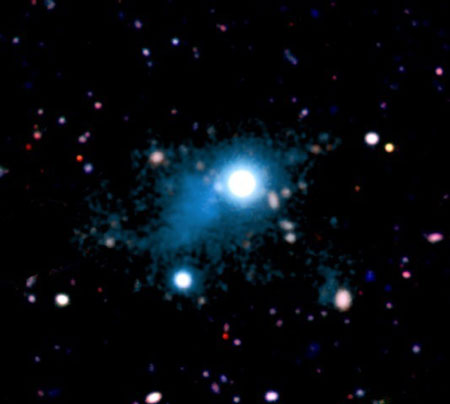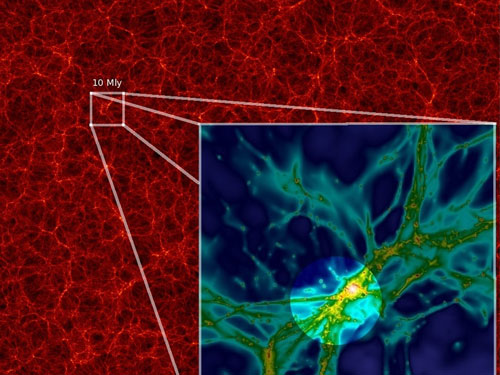| Jan 19, 2014 |
Black hole illuminates cosmic web
|
|
(Nanowerk News) Cosmologists generally believe that matter in intergalactic space is distributed in a vast network of interconnected filamentary structures of gas known as the cosmic web. The vast majority of atoms in the Universe reside in this web as primordial hydrogen, vestigial matter left over from the Big Bang. Researchers from the University of California at Santa Cruz and the Max Planck Institute for Astronomy have now captured an image of these filamentary structures for the first time. To achieve this, they exploited the intense radiation generated by a supermassive black hole in a quasar.
|
 |
| The observed portion of the cosmic web (collared cyan) with a size of about 2 million light-years, which was discovered in the vicinity of the quasar UM 287 (at the centre of the image). The gas is glowing thanks to the same effect that powers fluorescent lamps. This is the first extended image of part of the large-scale cosmic web of gas, which is thought to play a key role in supplying galaxies with the raw material to form new stars. (Image: S. Cantalupo/UCSC)
|
|
Supercomputer simulations predict that matter in the Universe is distributed in a network of filaments known as the 'cosmic web', where the vast majority of atoms reside as diffuse hydrogen gas. In this picture, galaxies like our own Milky Way formed at the nodes of this network, where cool dense gas, the fuel for star formation, funnels in along the intersecting filaments. But direct tests of this model were previously lacking, because even at the densest nodes, cosmic web gas is so rarefied that it emits very little light, making it impossible to image even with the world’s largest telescopes.
|
|
Now astronomers have obtained the first direct images of a portion of the cosmic web, by exploiting the fact that a luminous object known as a quasar can act like a natural `cosmic flashlight’. Quasars constitute a brief phase in the galactic life-cycle. Powered by the infall of matter onto a galaxy's central supermassive black hole, they shine as the most luminous objects in the Universe. Because the galaxies hosting quasars should also reside at dense nodes of the web, the quasar can illuminate nearby cosmic web gas, revealing its structure. Under the quasar-flashlight's intense glare, the gas emits light via the same mechanism at work in an ordinary fluorescent lamp, namely because it is being constantly bombarded with energy. In the case of ordinary lamps this energy is provided by an electrical current, whereas the cosmic web fluorescence is powered by energy from the quasar radiation.
|
|
Sebastiano Cantalupo, a post-doctoral researcher at the University of California at Santa Cruz and the lead author of the study ("Cosmic Web filament revealed in Lyman α emission around a luminous high-redshift Quasar"), says: "The light from the quasar is like a flashlight beam, and in this case, we were lucky that the flashlight is pointing right at the cosmic web, making some of its gas glow." Using the 10-meter Keck I Telescope at the W. M. Keck Observatory in Hawaii, the researchers were able to capture an image of the fluorescently glowing cosmic web with the help of a custom-made filter. Fluorescent light reaching us from the targeted portion of the cosmic web has a specific, characteristic colour – and only this colour is transmitted by the filter.
|
 |
| Space in the computer: Computer simulations indicate the existence of a cosmic web of gas filaments on length scales of millions of light-years and above. The simulation in the background of this image shows the distribution not of gas, but of dark matter, which does not emit any light at all (Bolshoi simulation by Anatoly Klypin and Joel Primack). This dark matter forms the backbone of the cosmic gas web. The inset is a zoomed-in, high-resolution image of a smaller part of the cosmic web, 10 million light-years across, from a simulation that includes gas as well as dark matter (simulation: S. Cantalupo). The intense radiation from a quasar can, like a flashlight, illuminate part of the surrounding cosmic web (highlighted in the image) and make a filament of gas glow, as was observed in the case of quasar UM287. (Image: A. Klypin/J. Primack and S. Cantalupo)
|
|
The hydrogen gas in intergalactic space has been indirectly studied for decades using a different and much more restricted technique that probes the cosmic web along a single line only – the line joining a distant background quasar with an observer here on Earth. But this method could never reveal the spatial structure of the cosmic web.
|
|
Fabrizio Arrigoni Battaia, who participated in the observations as part of the work for his doctoral degree at the Max Planck Institute for Astronomy, says: "This is the first time anyone has been able to capture an image of the cosmic web, demonstrating its filamentary structure." The region of the cosmic web visible on the image measures roughly 2 million light-years across.
|
|
Such observations can be used to test supercomputer models that simulate the formation of cosmic structures from the Big Bang to the present. Indeed, the new discovery provides evidence that key elements might be missing from current simulations: The amount of cool gas inferred from the image of the cosmic web appears to be substantially larger than predicted.
|
|
Joseph Hennawi, a group leader at the Max Planck Institute for Astronomy involved in the study, concludes: "If you want to know how galaxies form, you first need to understand their fuel supply, which comes from the cosmic web. These new observations are challenging our understanding, as they suggest a large amount of gas is contained in small dense clumps, which is not currently present in our models. Resolving this tension will clearly teach us something very important."
|


